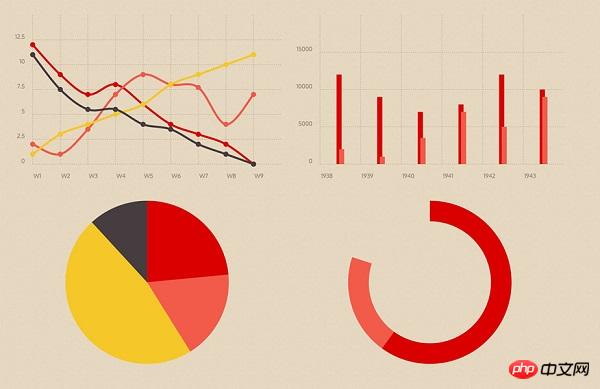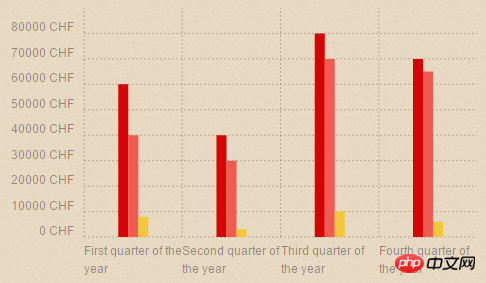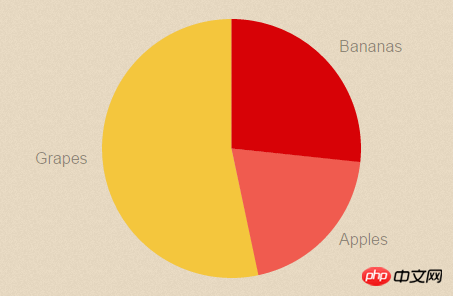 Web Front-end
Web Front-end
 JS Tutorial
JS Tutorial
 Detailed introduction to the powerful JavaScript responsive chart Chartist.js (image and text)
Detailed introduction to the powerful JavaScript responsive chart Chartist.js (image and text)
Detailed introduction to the powerful JavaScript responsive chart Chartist.js (image and text)
PowerfulJavaScriptResponsive chart Chartist.js
Chartist.js is a very simple and practical JavaScript front-end chartGenerator, it supports SVG format, chart data conversion is very flexible, and it also supports a variety of chart presentation forms, making it a development tool for front-end developers.
Chartist.js Features
The configuration is very simple and can easily convert various chart data formats.
CSS and JavaScript are separated, so the code is relatively concise and relatively convenient to use.
Uses SVG format, so Chartist.js can be flexibly applied on Web pages.
Responsive chart, supports different browser sizes and resolutions.
Supports custom SASS architecture.

How to use Chartist.js
First you need to download the JS package and CSS package from its official website, and Quote them on the page:
<link rel="stylesheet" href="bower_components/chartist/dist/chartist.min.css"> <script src="bower_components/chartist/dist/chartist.min.js">
Below we will give a brief introduction to some commonly used chart types.
Line chart with Tooltip prompt
Rendering:

new Chartist.Line('.ct-chart', {
labels: ['1', '2', '3', '4', '5', '6'],
series: [
{
name: 'Fibonacci sequence',
data: [1, 2, 3, 5, 8, 13]
},
{
name: 'Golden section',
data: [1, 1.618, 2.618, 4.236, 6.854, 11.09]
}
]
});
var easeOutQuad = function (x, t, b, c, d) {
return -c * (t /= d) * (t - 2) + b;
};
var $chart = $('.ct-chart');
var $toolTip = $chart
.append('<p class="tooltip"></p>')
.find('.tooltip')
.hide();
$chart.on('mouseenter', '.ct-point', function() {
var $point = $(this),
value = $point.attr('ct:value'),
seriesName = $point.parent().attr('ct:series-name');
$point.animate({'stroke-width': '50px'}, 300, easeOutQuad);
$toolTip.html(seriesName + '<br>' + value).show();
});
$chart.on('mouseleave', '.ct-point', function() {
var $point = $(this);
$point.animate({'stroke-width': '20px'}, 300, easeOutQuad);
$toolTip.hide();
});
$chart.on('mousemove', function(event) {
$toolTip.css({
left: (event.offsetX || event.originalEvent.layerX) - $toolTip.width() / 2 - 10,
top: (event.offsetY || event.originalEvent.layerY) - $toolTip.height() - 40
});
});
new Chartist.Bar('.ct-chart', {
labels: ['First quarter of the year', 'Second quarter of the year', 'Third quarter of the year', 'Fourth quarter of the year'],
series: [
[60000, 40000, 80000, 70000],
[40000, 30000, 70000, 65000],
[8000, 3000, 10000, 6000]
]
}, {
seriesBarDistance: 10,
axisX: {
offset: 60
},
axisY: {
offset: 80,
labelInterpolationFnc: function(value) {
return value + ' CHF'
},
scaleMinSpace: 15
}
}); ##JavaScript code:
##JavaScript code:
var data = {
labels: ['Bananas', 'Apples', 'Grapes'],
series: [20, 15, 40]
};
var options = {
labelInterpolationFnc: function(value) {
return value[0]
}
};
var responsiveOptions = [
['screen and (min-width: 640px)', {
chartPadding: 30,
labelOffset: 100,
labelDirection: 'explode',
labelInterpolationFnc: function(value) {
return value;
}
}],
['screen and (min-width: 1024px)', {
labelOffset: 80,
chartPadding: 20
}]
];
new Chartist.Pie('.ct-chart', data, options, responsiveOptions);For more information about the usage of Chartist.js, you can go to its official website to check, including detailed
APIThe above is the detailed content of Detailed introduction to the powerful JavaScript responsive chart Chartist.js (image and text). For more information, please follow other related articles on the PHP Chinese website!

Hot AI Tools

Undresser.AI Undress
AI-powered app for creating realistic nude photos

AI Clothes Remover
Online AI tool for removing clothes from photos.

Undress AI Tool
Undress images for free

Clothoff.io
AI clothes remover

Video Face Swap
Swap faces in any video effortlessly with our completely free AI face swap tool!

Hot Article

Hot Tools

Notepad++7.3.1
Easy-to-use and free code editor

SublimeText3 Chinese version
Chinese version, very easy to use

Zend Studio 13.0.1
Powerful PHP integrated development environment

Dreamweaver CS6
Visual web development tools

SublimeText3 Mac version
God-level code editing software (SublimeText3)

Hot Topics
 1659
1659
 14
14
 1415
1415
 52
52
 1310
1310
 25
25
 1258
1258
 29
29
 1232
1232
 24
24
 How to implement an online speech recognition system using WebSocket and JavaScript
Dec 17, 2023 pm 02:54 PM
How to implement an online speech recognition system using WebSocket and JavaScript
Dec 17, 2023 pm 02:54 PM
How to use WebSocket and JavaScript to implement an online speech recognition system Introduction: With the continuous development of technology, speech recognition technology has become an important part of the field of artificial intelligence. The online speech recognition system based on WebSocket and JavaScript has the characteristics of low latency, real-time and cross-platform, and has become a widely used solution. This article will introduce how to use WebSocket and JavaScript to implement an online speech recognition system.
 WebSocket and JavaScript: key technologies for implementing real-time monitoring systems
Dec 17, 2023 pm 05:30 PM
WebSocket and JavaScript: key technologies for implementing real-time monitoring systems
Dec 17, 2023 pm 05:30 PM
WebSocket and JavaScript: Key technologies for realizing real-time monitoring systems Introduction: With the rapid development of Internet technology, real-time monitoring systems have been widely used in various fields. One of the key technologies to achieve real-time monitoring is the combination of WebSocket and JavaScript. This article will introduce the application of WebSocket and JavaScript in real-time monitoring systems, give code examples, and explain their implementation principles in detail. 1. WebSocket technology
 How to use JavaScript and WebSocket to implement a real-time online ordering system
Dec 17, 2023 pm 12:09 PM
How to use JavaScript and WebSocket to implement a real-time online ordering system
Dec 17, 2023 pm 12:09 PM
Introduction to how to use JavaScript and WebSocket to implement a real-time online ordering system: With the popularity of the Internet and the advancement of technology, more and more restaurants have begun to provide online ordering services. In order to implement a real-time online ordering system, we can use JavaScript and WebSocket technology. WebSocket is a full-duplex communication protocol based on the TCP protocol, which can realize real-time two-way communication between the client and the server. In the real-time online ordering system, when the user selects dishes and places an order
 How to implement an online reservation system using WebSocket and JavaScript
Dec 17, 2023 am 09:39 AM
How to implement an online reservation system using WebSocket and JavaScript
Dec 17, 2023 am 09:39 AM
How to use WebSocket and JavaScript to implement an online reservation system. In today's digital era, more and more businesses and services need to provide online reservation functions. It is crucial to implement an efficient and real-time online reservation system. This article will introduce how to use WebSocket and JavaScript to implement an online reservation system, and provide specific code examples. 1. What is WebSocket? WebSocket is a full-duplex method on a single TCP connection.
 JavaScript and WebSocket: Building an efficient real-time weather forecasting system
Dec 17, 2023 pm 05:13 PM
JavaScript and WebSocket: Building an efficient real-time weather forecasting system
Dec 17, 2023 pm 05:13 PM
JavaScript and WebSocket: Building an efficient real-time weather forecast system Introduction: Today, the accuracy of weather forecasts is of great significance to daily life and decision-making. As technology develops, we can provide more accurate and reliable weather forecasts by obtaining weather data in real time. In this article, we will learn how to use JavaScript and WebSocket technology to build an efficient real-time weather forecast system. This article will demonstrate the implementation process through specific code examples. We
 Simple JavaScript Tutorial: How to Get HTTP Status Code
Jan 05, 2024 pm 06:08 PM
Simple JavaScript Tutorial: How to Get HTTP Status Code
Jan 05, 2024 pm 06:08 PM
JavaScript tutorial: How to get HTTP status code, specific code examples are required. Preface: In web development, data interaction with the server is often involved. When communicating with the server, we often need to obtain the returned HTTP status code to determine whether the operation is successful, and perform corresponding processing based on different status codes. This article will teach you how to use JavaScript to obtain HTTP status codes and provide some practical code examples. Using XMLHttpRequest
 How to use insertBefore in javascript
Nov 24, 2023 am 11:56 AM
How to use insertBefore in javascript
Nov 24, 2023 am 11:56 AM
Usage: In JavaScript, the insertBefore() method is used to insert a new node in the DOM tree. This method requires two parameters: the new node to be inserted and the reference node (that is, the node where the new node will be inserted).
 JavaScript and WebSocket: Building an efficient real-time image processing system
Dec 17, 2023 am 08:41 AM
JavaScript and WebSocket: Building an efficient real-time image processing system
Dec 17, 2023 am 08:41 AM
JavaScript is a programming language widely used in web development, while WebSocket is a network protocol used for real-time communication. Combining the powerful functions of the two, we can create an efficient real-time image processing system. This article will introduce how to implement this system using JavaScript and WebSocket, and provide specific code examples. First, we need to clarify the requirements and goals of the real-time image processing system. Suppose we have a camera device that can collect real-time image data



